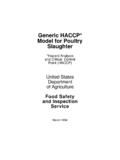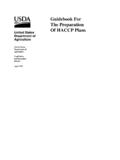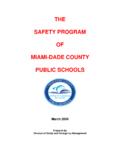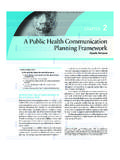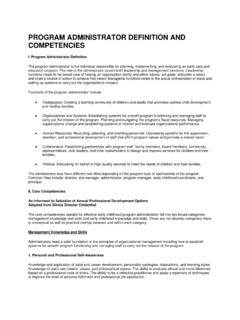Transcription of Heat Treated Not Fully Cooked, Not Shelf-Stable
1 GENERIC HACCP MODELFORHeat Treated Not Fully cooked , NotShelf-StableDeveloped:June 26-28, 1996 Kansas City, MOSubmitted toUSDA, Food safety and Inspection Serviceby theInternational Meat and Poultry HACCP AllianceonSeptember 9, 1996 heat Treated Not Fully cooked , Not shelf -StableTABLE OF CONTENTS SECTION PAGE Introduction ..2 Seven Principles of About this Generic model .. 4 Using this Generic model to Develop and Implement a HACCP Program ..6 Process Category DescriptionsPartially cooked Categories and IngredientsPartially cooked Sausage ..12 Flow Chart ..13 Hazard Analysis Worksheet ..14 HACCP Worksheet ..21 Examples of Record-Keeping Forms ..25 Appendix 1 (21 CFR Part 110)..31 Appendix 2 (Process Categories).
2 41 Appendix 3 (Overview of Hazards) ..43 Appendix 4 (NACMCF Decision Tree) ..45 Appendix 5 (References) ..47 heat Treated Not Fully cooked , Not shelf -StableGENERIC HACCP MODELFORHeat Treated Not Fully cooked , Not shelf -StableIntroduction:Hazard Analysis Critical Control Point (HACCP) is a systematic, scientific approach to processcontrol. It is designed to prevent the occurrence of problems by ensuring that controls are applied atany point in a food production system where hazardous or critical situations could occur. Hazards caninclude biological, chemical or physical contamination of food United States Department of Agriculture (USDA) published a final rule in July 1996 mandatingthat HACCP be implemented as the system of process control in all USDA inspected meat and poultryplants.
3 As part of its effort to assist establishments in the preparation of plant-specific HACCP plans,FSIS determined that a generic model for each process defined in the regulation will be made availablefor use by the May 1996, the Department of Agriculture (USDA) Food safety and Inspection Service (FSIS)awarded Contract Number 53-3A94-6-04 to the International Meat and Poultry HACCP Alliance forthe development of ten generic HACCP models. The ten models developed were:1. Not heat Treated , Shelf-Stable (dried products, those controlled by water activity, pH, freezedried, dehydrated, etc.)2. heat Treated , Shelf-Stable (rendered products, lard, etc.)3. heat Treated Not Fully cooked , Not Shelf-Stable (ready to cook poultry, cold smoked andproducts smoked for trichinae, partially cooked battered, breaded, char-marked, batter set, andlow temperature rendered products, etc.)
4 4. Products with Secondary Inhibitors, Not Shelf-Stable (products that are fermented, dried,salted, brine Treated , etc., but are not Shelf-Stable )5. Irradiation (includes all forms of approved irradiation procedures for poultry and pork)6. Fully cooked , not shelf stable (products which have received a lethal kill step through aheating process, but must be kept refrigerated. This includes products such as Fully cookedhams, cooked beef, roast beef, etc.).7. Beef Slaughter8. Pork Slaughter9. Poultry Slaughter10. Raw Products - not ground (all raw products which are not ground in their final form. Thisincludes beef trimmings, tenderized cuts, steaks, roasts, chops, poultry parts, etc.)USDA developed three additional models:1.
5 Raw, Ground2. Thermally Processed/Commercially Sterile3. Mechanically Separated Species/Deboned PoultryThis document contains the generic HACCP model for the process category titled: heat Treated Not Fully cooked , Not Shelf-Stable . In order to develop this model , a literature review and an epidemiological assessment of the productsselected were performed to present an overview of the microbiological characteristics and profile of theproduct. This information then was reviewed by a team of industry, academic, public health officials, heat Treated Not Fully cooked , Not shelf -Stableand consumer representatives. The team met in a workshop in Kansas City, MO on June 26-28, to the workshop, this generic HACCP model was reviewed by small businessestablishments for clarity and usability, and it was submitted to an expert peer review panel fortechnical HACCP plans serve as useful guidelines; however, it is impossible for a generic model for tobe developed without it being too general.
6 Therefore, it is incumbent on each plant s HACCP Team totailor this model to fit products in each plant, based on the knowledge about the process. Severalpoints should be considered when using this model to develop specific HACCP plants shall have Sanitation Standard Operating Procedures (SSOPs). Good ManufacturingPractices (GMPs) (FDA, 21 CFR 110; Appendix 1) and Standard Operating Procedures (SOPs) maybe in place as the foundation of the HACCP program. Good Manufacturing Practices are minimumsanitary and processing requirements applicable to all companies processing food. Standard OperatingProcedures (SOPs) are step-by-step directions for completing important plant procedures. SOPsshould specifically describe the method for conducting and controlling the procedure.
7 SOPs should beevaluated regularly ( , daily) to confirm proper and consistent application, and modified asnecessary to ensure generic model can be used as a starting point for the development of your plant-specific planreflecting your plant environment and the specific processes conducted. The generic model is notintended to be used as is for your plant-specific HACCP generic models designed for use in developing a plant-specific HACCP plan are defined accordingto process category. In order to select the model or models that will be most useful for the activitiesperformed in your plant, the following steps should be a model for a slaughter operation is required, select the model for the appropriate species.
8 If a modelfor a processed product or products is required, make a list of all products produced in the the list and group all like products according to common processing steps and equipmentused. Compare these to the list of Process Models in Appendix 1. After reviewing and grouping theproducts produced, you will know the number of models that are needed to assist in developing yourplant-specific an establishment is a combination plant, conducting both slaughter and processing activities, thetwo models can be merged into a plant-specific plan. In this case, over-lapping critical control points(CCPs) can be combined as long as all significant hazards are Principles of HACCP:The following seven principles of HACCP were adopted by the National Advisory Committee onMicrobiological Criteria of Foods (NACMCF, 1992):1.
9 Conduct a hazard analysis. Prepare a list of steps in the process where significant hazardsoccur and describe the preventive types of hazards: Biological (B) primarily concerned with pathogenic bacteria, such as Salmonella,Staphylococcus aureus, Campylobacter jejuni, Clostridium perfringens,Clostridium botulinum, Listeria monocytogenes, and Escherichia coli O157:H7;also should consider Trichinella sprialis, and other parasites, as well as potentialpathological concerns. Chemical (C) toxic substances or compounds that may be unsafe for consumption; , cleaners, sanitizers, pesticides, insecticides, rodenticides, paint, lubricants, Treated Not Fully cooked , Not Shelf-Stable Physical (P) foreign objects which may injure the consumer; , rocks, stones,wood, metal, glass, nuts, bolts, screws, plastic, knife blades, Identify the critical control points (CCPs) in the process.
10 A critical control point is definedas a point, step or procedure at which control can be applied and a food safety hazard canbe prevented, eliminated or reduced to an acceptable Establish critical limits for preventive measures associated with each identified CCP. Acritical limit is defined as a criterion that must be met for each preventive measureassociated with a CCP. Each CCP will have one or more preventive measures that must beproperly controlled to assure prevention, elimination or reduction of hazards to acceptablelevels. Each preventive measure has associated with it critical limits that serve asboundaries of safety for each Establish CCP monitoring requirements. Establish procedures for using the results ofmonitoring to adjust the process and maintain Establish corrective action(s) to be taken when monitoring indicates that there is a deviationfrom an established critical Establish effective record-keeping procedures that document the HACCP Establish procedures for verification that the HACCP system is working about this Generic model :1.
